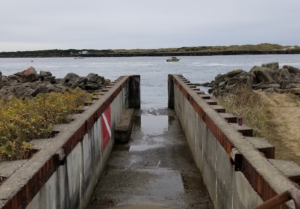Oregon is a world-class destination for outdoor activities like mountaineering, climbing, and kayaking. It is also a surprisingly good place to dive with a number of dive shops calling this state home. Of the many beautiful dive sites in Oregon, perhaps the most popular is the North Jetty Dive Park in Florence. In 2003, this site became an official dive park and the old fish ladder that jutted into the Siuslaw River was converted into a user-friendly entrance.
Diving at North Jetty Dive Park

Where once entering the site meant scrambling over a wall of jetty rocks, today entering is as simple as walking down a few stairs. There’s even a staging area for gear if you have a few things to set down.
While Oregon does offer some good saltwater diving opportunities, many of the dive sites, like the North Jetty Dive Park, are located a little upstream of the river mouth. These often sit along a more-protected bank or behind rocky fingers. The dive park is popular with divers from all over the state and is a hotbed for those who have a shellfish license or who enjoy collecting cockles and crabbing.
Instructors also use North Jetty for scuba training, as it is easy to navigate — a due-north heading will run you straight into the jetty rocks. Ascend along these rocks and you’ll be on the right side of the channel. Given that Florence still has a fairly active fishing community, boat traffic is a concern. Providing you ascend along the jetty rocks and not in the middle of the channel, however, you shouldn’t have any problem.
When you first swim out, you’ll be in a small, protected area. Descend here and follow a large pipe down to about 20 feet (6 m). Where the pipe ends, drop straight down the jetty floor, which is at about 35 feet (11 m). Here you will find two objects that you can use as navigational aids — a brass crab measurer and a handrail — that divers refer to as the “viz checker.” If you can see from one end of the handrail to the other, you have 10 feet (3 m) of visibility. Any less than that and your guess is as good as your buddy’s.
When to dive North Jetty
It is very important to dive this site at slack tide, as there can be a fair bit of current. Swim into the current on your way out, and ride the current back to the entrance on your return. If you dive the site enough, you will become familiar with some key markers that help you figure out where you are.
The best time to dive the site is at high slack. Not only is visibility usually better, but heading upriver will also take you in the direction of the crab hole. To get there, simply keep the rocks to your left. After a few minutes you will be atop a pock-marked sandstone shelf, home to a shellfish called the rough piddock. You may sometimes spot a wolf eel in the shelf wall or in nearby rocks. The crab hole drops down to between 55 to 60 feet. Other common marine life includes various sculpins, nudibranchs, chitons, anemones, kelp, white-spotted greenling, lingcod and, if you’re lucky, octopus and wolf eels.
If you arrive before high tide and have two vehicles available, you can always ride the tide in from the Coast Guard tower, which is located a little further up the jetty. Entering here is not for the faint of heart, however, and is a bit of a rock scramble. Be careful if you do this, and make sure you kick away from the rocks as soon as you enter the water.
Visibility and nearby sites
Visibility at these sites can be anywhere from 2 feet to 25 feet (.6 to 8 m). For the most part, expect around 10 feet. If visibility is terrible and you don’t fancy a drift dive, Woahink Lake is a great backup option. It’s only about 7 miles (11 km) away and is a favorite for new divers and certifying dive shops. The lake has many points of interest as well, especially if you use the Canary Road exit off the Oregon Coast Highway and enter from the boat ramp immediately after the first bridge. Here you will find a number of sunken boats and other peculiar attractions that you must see to believe.
Candice Landau is a PADI divemaster based in the Pacific Northwest. She’s also a diver at the Oregon Coast Aquarium, a member of the Maritime Archaeological Society, and a Scientific Diver affiliated with Oregon State University. When she isn’t diving, she’s writing about diving. You can learn more about her adventures on her website.





